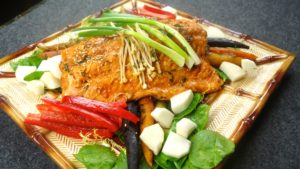++++++++++++++++++++++++++++++++++++++++++++++++++
Food Trends
+++++++++++++++++++++++++++++++++++++++++++++++

Korean Inspired Oven Poached Salmon Dinner
About the Recipe: Take a trip to the other side of the world with sweet spiced tender carrots, caramelized onions, and sautéed mushrooms served with a gently oven poached salmon. Serve with crisp chunks of radishes, red peppers, and vitamin rich spinach. Additional Gochujang sauce can be drizzled over the dish if desired.
Information About:
The LoBok Radish: Korean radishes are larger than most common radishes. They have a crisp, firm flesh that offers a relatively mild radish flavor and spice. Its thick, smooth skin is creamy white and capped with pale green shoulders. Though commonly sold with the greens removed both the root and the greens of this radish are edible. Its flesh is white with a texture and taste similar to that of the daikon radish. Unlike the carrot shaped daikon however, the Korean radish is rounded and plump with an oblong shape.
Both the raw Korean radish and the kimchee are popularly used in Korean cuisine and are believed to be beneficial in supporting digestive health. The Korean radish is most commonly used as an ingredient in kimchee. They are also popularly sliced thin, pickled and served as an appetizer or accompaniment to grilled meats. Its flesh is dense and crisp and stands up well to cooking. Add to soups, stews and stir-fries or slice thick and braise with pork or beef. Raw Korean radish can be thinly sliced and added to salads or banh mi sandwiches. To store, wrap tightly in plastic and refrigerate.
For More Information See:
http://www.specialtyproduce.com/produce/Korean_Radish_178.php
Enoki Mushrooms:
These long, thin mushrooms with tiny caps are commonly found in Asian dishes. They are packaged in clusters and have a very crisp texture.
To warm the mushrooms, this recipe uses the residual heat of the roasted salmon. They readily take on the flavors of the dish to which you add them, so it won’t taste like you just tossed them in as an afterthought. Add enoki mushrooms to the hot soup, sauce or stir-fry right before serving it.
https://www.leaf.tv/articles/how-to-cook-enoki-mushrooms/
What Is Gochujang?
Gochujang is a red chile paste that also contains glutinous rice, fermented soybeans, salt, and sometimes sweeteners. It’s a thick, sticky condiment that’s spicy and very concentrated and pungent in flavor. Heat levels can vary between brands, so check the packaging to see if it’s labeled with any kind of spice-level indicator. Gochujang can be used in marinades for meat dishes like Korean bulgogi, stirred into dipping sauces, or used to punch up stews or soups. A hot pepper paste is one of the backbone ingredients of Korean cooking.
For More Information See:
http://www.thekitchn.com/gochujang-the-miso-of-korean-cooking-ingredient-intelligence-165083
Rainbow Carrots:
Carrots are very versatile and healthy vegetables and add color to any meal.
What do we know about the nutritional value of colored carrots?
The color of yellow, orange and red carrots is the result of certain carotenoid pigments present in the root. These carotenoids can be divided into hydrocarbon pigments or carotenes and oxygenated pigments or xanthophylls.
- Xanthophylls, similar to beta-carotene, give yellow carrots their golden colors; they are linked to eye health and may reduce the incidence of lung and other cancers.
- Lycopene, found in red carrots, is a type of carotene also found in tomatoes. It is believed to help prevent heart disease and, in conjunction with other phytochemicals, reduce the risk of certain cancers, including prostate cancer.
- Anthocyaninsand pigments of the flavonoid (as opposed to carotenoid) class are found in purple carrots. In the human body these pigments act as powerful antioxidants, immobilizing harmful free radicals. Anthocyanins can also help reduce the risk of heart disease by slowing blood clotting.
- Whitecarrots lack pigment but may contain other beneficial phytochemicals. More research is needed.
- Luteinis one of the hydroxy carotenoids found in yellow and orange carrots and makes up the macular pigment of human retinas. Consuming foods high in lutein may increase the density of this pigment and decrease the risk for developing macular degeneration and other age-related diseases.
For more information: See:
http://www.carrotmuseum.co.uk/carrotcolours.html
http://www.sensationalcolor.com/color-for-your-home/gourmet-color/rainbow-carrots-746#.WHBXLfkrLXU
pdf for Copy of Recipe – Korean Inspired Oven Poached Salmon Dinner
++++++++++++++++++++++++++++++++++++++++++++++++++
![]()


